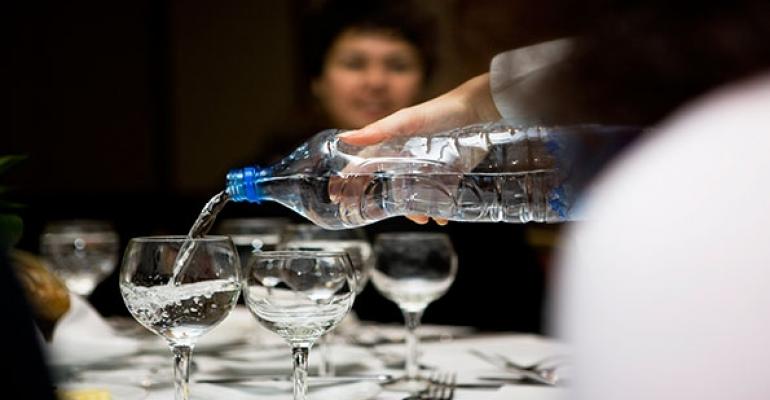Water has sometimes been treated as a commodity to splash about without a thought. But in a growing number of American restaurants, it is being recast as a substance of value.
A few operators are diving deeply into water menus that showcase distinctive bottled mineral waters. Others are infusing water with fruit juices and herbs to create light, refreshing alternatives to sugary carbonated soft drinks.
Against the backdrop of the prolonged California drought and its serious environmental implications, awareness is rising that water is a limited resource that should not be taken for granted.
For some operators, this spells an opportunity to promote water as a beverage worthy of respect, if not veneration.
“I believe there is room for a quality upgrade in water, whether it is bottled water or one of the new systems that offer adjusted, filtered tap water,” says James Tidwell, master sommelier and beverage manager of the Four Seasons Resort and Club Dallas at Las Colinas in Irving, Texas.
Tidwell observes that a bottled water menu that highlights the differences among waters — such as the various flavors of dissolved minerals and how the size of bubbles affects the mouth feel of sparkling waters — may appeal to customers in the millennial generation who enjoy sampling new food and beverage sensations.
However, he emphasizes that selling a water menu depends on operator effort. “It requires education on the part of sommeliers and managers, and how much they get behind the idea of expanding water programs,” Tidwell says.
Vigorous promotion of bottled water is paying off for the Patina Restaurant Group, a boutique restaurant company with 60 locations on both coasts. In 2013, the company launched a 45-page, 20-item bottled water menu in its Ray’s and Stark Bar in Los Angeles, garnering widespread media coverage and increasing bottled water sales by 500 percent.
The menu, spearheaded by water sommelier Martin Riese and sourced from locales such as Spain, Denmark and Fiji as well as the United States, is priced at $8 to $20 per bottle. It was subsequently introduced at the company’s flagship Patina restaurant in Los Angeles as well. This year, the Fine Water Society honored Joachim Splichal, the Patina group’s founder and chef, with an achievement award for the company’s strides in establishing water menus.
This summer Patina plans to offer six fine waters at its restaurants and concessions at the 18,000-seat Hollywood Bowl outdoor music venue in the Hollywood Hills and at Descanso Gardens, a local botanical garden. According to Riese, the company is considering water menus for its New York City restaurants as well.
While a high-end restaurant might promote 20 or more fine waters with a range of origins, mineral content and effervescence, a selection of six would work for a café or bistro, according to Michael Mascha, a Texas-based water expert and trainer of restaurant staff.
It is important to match the sophistication of the water to the sophistication of the food. “If your menu has a long description of where the line-caught fish comes from, then your water should have a more detailed description than just still or sparkling — it comes from rainwater, it is very soft, very neutral, and so on,” Mascha says.
At The Bazaar by Jose Andres at the SLS Hotel Beverly Hills, Los Angeles, detailed tasting notes highlight an eight-bottle menu of waters from France, the United Kingdom, New Zealand, Italy, Germany and Spain. “They are fun talking points to share with guests,” says Vahan Petrossian, beverage manager of The Bazaar.
Water has been reborn as a light, flavorful and profitable refresher at Lyfe Kitchen, a Memphis, Tenn.-based chain of 16 restaurants that touts good-for-you fare that also tastes good.
The Lyfe Waters selection includes Orange Ginger Chia, made with filtered water, fresh-squeezed orange juice, lime, ginger, mint and chia seeds and Ginger Mint Chia, filtered water infused with ginger, lime, mint and chia seeds.
The restaurants are each selling an average of 60 Lyfe Waters per day, priced at $1.49 to $2.99 each, reports Lyfe Kitchen corporate executive chef Jeremy Bringardner. These sales have filled the gap that formerly existed when patrons got in the habit of choosing free tap water rather than purchasing a beverage.
“We went from selling barely any beverages to selling tons of them,” Bringardner says. “At first we priced the waters at 99 cents, then we increased the prices because we realized they sold not because they were cheap but because they are exactly what customers want — low-calorie, tasty and interesting beverages.”





